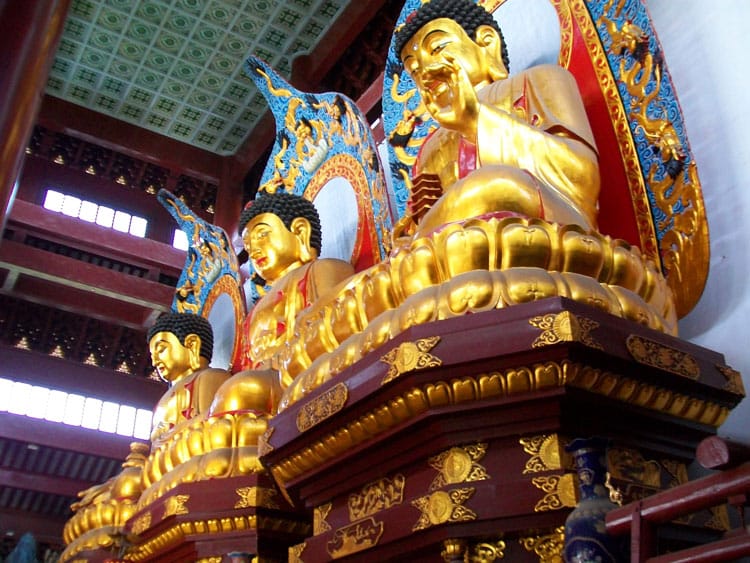Case 51 never ends, yet we turn to Case 52 ... Sozan's Dharmakaya ...
Dharmakaya might be said to be reality in its most ultimate sense, beyond subject and object, all individual people and things, coming and going and all birth and death ... so ultimate in fact that we dare not even put a name on it (even "it" or "Dharmakaya"!) for to do so is just to limit. This is what we are too. As the Preamble says, "comparisons cannot be made, and when it is impossible to find something similar or identical, how can it be expressed?" And as well, this Dharmakaya is precisely all people and things, you and me too.
The image of the moon in the water reminds me of this most beautiful image painted by Dogen in his Genjo Koan ...
As to the Donkey and the Well (probably the image is the donkey seeing his own self in the well water), I believe there is some play here on the fact that you might realize that "you are the Dharmakaya", but do you realize that "the Dharmakaya is precisely you"? Better said (because, in Zen speak, that is still "only 80%"), what "you" and what "Dharmakaya" (because even thinking in such way creates the image of two things). As well, each drop of water (of which you are one) holds comfortably and fully expresses the entire moon!
Thus, for example, the Heart Sutra chants, "form is no other than emptiness, emptiness no other than form. Form is exactly emptiness, emptiness exactly form." The Sufi mystic Kabir taught, "All know that the drop merges into the ocean, but few know that the ocean merges into the drop.” Dogen also spoke in the Genjo ...
I am not sure, but probably the images in the closing Verse of "loom threads don't hang" and "patterns emerge every which way" means something like every thread and pattern (of which you and I are two) of the rug are just the rug, and the rug is precisely its threads and patterns. Since the threads are precisely the rug, and rug just threads ... and this rug is an ongoing work in progress, with threads constantly being added (birth) and replaced on the loom ... though a thread may break (death) this rug stretches boundlessly on and on ... and all is precisely who you and I are all along ...
SUGGESTED QUESTION:
Do you feel like the donkey or the well, the moon or the water?
Gassho, J

The donkey looks at (its reflection in) the well
The well looks at the Donkey
Dharmakaya might be said to be reality in its most ultimate sense, beyond subject and object, all individual people and things, coming and going and all birth and death ... so ultimate in fact that we dare not even put a name on it (even "it" or "Dharmakaya"!) for to do so is just to limit. This is what we are too. As the Preamble says, "comparisons cannot be made, and when it is impossible to find something similar or identical, how can it be expressed?" And as well, this Dharmakaya is precisely all people and things, you and me too.
The image of the moon in the water reminds me of this most beautiful image painted by Dogen in his Genjo Koan ...
Enlightenment is like the moon reflected on the water. The moon does not get wet, nor is the water broken. Although its light is wide and great, the moon is reflected even in a puddle an inch wide. The whole moon and the entire sky are reflected in dewdrops on the grass, or even in one drop of water.
Enlightenment does not divide you, just as the moon does not break the water. You cannot hinder enlightenment, just as a drop of water does not hinder the moon in the sky. The depth of the drop is the height of the moon. Each reflection, however long or short its duration, manifests the vastness of the dewdrop, and realizes the limitlessness of the moonlight in the sky.
http://www.thezensite.com/ZenTeachin...GenjoKoan8.htm
Enlightenment does not divide you, just as the moon does not break the water. You cannot hinder enlightenment, just as a drop of water does not hinder the moon in the sky. The depth of the drop is the height of the moon. Each reflection, however long or short its duration, manifests the vastness of the dewdrop, and realizes the limitlessness of the moonlight in the sky.
http://www.thezensite.com/ZenTeachin...GenjoKoan8.htm
Thus, for example, the Heart Sutra chants, "form is no other than emptiness, emptiness no other than form. Form is exactly emptiness, emptiness exactly form." The Sufi mystic Kabir taught, "All know that the drop merges into the ocean, but few know that the ocean merges into the drop.” Dogen also spoke in the Genjo ...
To carry the self forward and illuminate myriad things is delusion. That myriad things come forth and illuminate the self is awakening. ... To study the buddha way is to study the self. To study the self is to forget the self. To forget the self is to be actualized by myriad things. When actualized by myriad things, your body and mind as well as the bodies and minds of others drop away. No trace of realization remains, and this no-trace continues endlessly. When you first seek dharma, you imagine you are far away from its environs. At the moment when dharma is correctly transmitted, you are immediately your original self.
SUGGESTED QUESTION:
Do you feel like the donkey or the well, the moon or the water?
Gassho, J

The donkey looks at (its reflection in) the well
The well looks at the Donkey

 ) ) that developed in Mahayana Buddhism early on (although with roots in earlier Buddhism). In a nutshell:
) ) that developed in Mahayana Buddhism early on (although with roots in earlier Buddhism). In a nutshell:




Comment